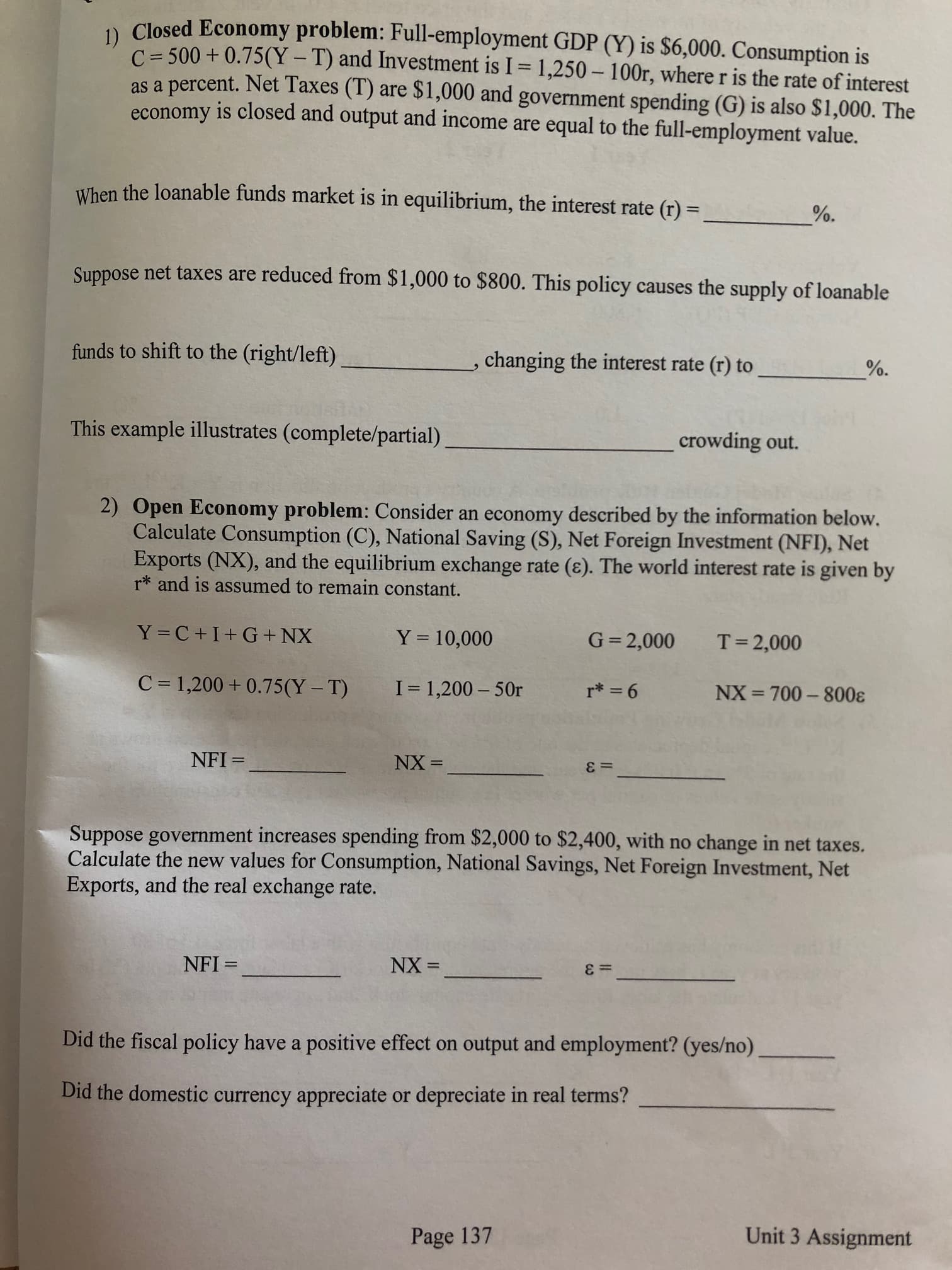1. Closed Economy problem: Full-employment GDP (Y) is $6,000. Consumption is C= 500 + 0.75(Y – T) and Investment is I= 1,250 – 100r, wherer is the rate of interest as a percent. Net Taxes (T) are $1,000 and government spending (G) is also $1,000. The economy is closed and output and income are equal to the full-employment value. When the loanable funds market is in equilibrium, the interest rate (r) = %. Suppose net taxes are reduced from $1,000 to $800. This policy causes the supply of loanable funds to shift to the (right/left) changing the interest rate (r) to %. This example illustrates (complete/partial) crowding out. 2) Open Economy problem: Consider an economy described by the information below. Calculate Consumption (C), National Saving (S), Net Foreign Investment (NFI), Net Exports (NX), and the equilibrium exchange rate (ɛ). The world interest rate is given by r* and is assumed to remain constant. Y=C+I+G + NX Y = 10,000 G=2,000 T= 2,000 C = 1,200 + 0.75(Y – T) I = 1,200 – 50r r* = 6 NX = 700 - 800ɛ NFI = NX = %3D =D3 Suppose government increases spending from $2,000 to $2,400, with no change in net taxes. Calculate the new values for Consumption, National Savings, Net Foreign Investment, Net Exports, and the real exchange rate. NFI = NX = = 3 Did the fiscal policy have a positive effect on output and employment? (yes/no) Did the domestic currency appreciate or depreciate in real terms?
1. Closed Economy problem: Full-employment GDP (Y) is $6,000. Consumption is C= 500 + 0.75(Y – T) and Investment is I= 1,250 – 100r, wherer is the rate of interest as a percent. Net Taxes (T) are $1,000 and government spending (G) is also $1,000. The economy is closed and output and income are equal to the full-employment value. When the loanable funds market is in equilibrium, the interest rate (r) = %. Suppose net taxes are reduced from $1,000 to $800. This policy causes the supply of loanable funds to shift to the (right/left) changing the interest rate (r) to %. This example illustrates (complete/partial) crowding out. 2) Open Economy problem: Consider an economy described by the information below. Calculate Consumption (C), National Saving (S), Net Foreign Investment (NFI), Net Exports (NX), and the equilibrium exchange rate (ɛ). The world interest rate is given by r* and is assumed to remain constant. Y=C+I+G + NX Y = 10,000 G=2,000 T= 2,000 C = 1,200 + 0.75(Y – T) I = 1,200 – 50r r* = 6 NX = 700 - 800ɛ NFI = NX = %3D =D3 Suppose government increases spending from $2,000 to $2,400, with no change in net taxes. Calculate the new values for Consumption, National Savings, Net Foreign Investment, Net Exports, and the real exchange rate. NFI = NX = = 3 Did the fiscal policy have a positive effect on output and employment? (yes/no) Did the domestic currency appreciate or depreciate in real terms?
Chapter1: Making Economics Decisions
Section: Chapter Questions
Problem 1QTC
Related questions
Question
question 1

Transcribed Image Text:1. Closed Economy problem: Full-employment GDP (Y) is $6,000. Consumption is
C= 500 + 0.75(Y – T) and Investment is I= 1,250 – 100r, wherer is the rate of interest
as a percent. Net Taxes (T) are $1,000 and government spending (G) is also $1,000. The
economy is closed and output and income are equal to the full-employment value.
When the loanable funds market is in equilibrium, the interest rate (r) =
%.
Suppose net taxes are reduced from $1,000 to $800. This policy causes the supply of loanable
funds to shift to the (right/left)
changing the interest rate (r) to
%.
This example illustrates (complete/partial)
crowding out.
2) Open Economy problem: Consider an economy described by the information below.
Calculate Consumption (C), National Saving (S), Net Foreign Investment (NFI), Net
Exports (NX), and the equilibrium exchange rate (ɛ). The world interest rate is given by
r* and is assumed to remain constant.
Y=C+I+G + NX
Y = 10,000
G=2,000
T= 2,000
C = 1,200 + 0.75(Y – T)
I = 1,200 – 50r
r* = 6
NX = 700 - 800ɛ
NFI =
NX =
%3D
=D3
Suppose government increases spending from $2,000 to $2,400, with no change in net taxes.
Calculate the new values for Consumption, National Savings, Net Foreign Investment, Net
Exports, and the real exchange rate.
NFI =
NX =
= 3
Did the fiscal policy have a positive effect on output and employment? (yes/no)
Did the domestic currency appreciate or depreciate in real terms?
Expert Solution
This question has been solved!
Explore an expertly crafted, step-by-step solution for a thorough understanding of key concepts.
This is a popular solution!
Trending now
This is a popular solution!
Step by step
Solved in 2 steps

Knowledge Booster
Learn more about
Need a deep-dive on the concept behind this application? Look no further. Learn more about this topic, economics and related others by exploring similar questions and additional content below.Recommended textbooks for you


Principles of Economics (12th Edition)
Economics
ISBN:
9780134078779
Author:
Karl E. Case, Ray C. Fair, Sharon E. Oster
Publisher:
PEARSON

Engineering Economy (17th Edition)
Economics
ISBN:
9780134870069
Author:
William G. Sullivan, Elin M. Wicks, C. Patrick Koelling
Publisher:
PEARSON


Principles of Economics (12th Edition)
Economics
ISBN:
9780134078779
Author:
Karl E. Case, Ray C. Fair, Sharon E. Oster
Publisher:
PEARSON

Engineering Economy (17th Edition)
Economics
ISBN:
9780134870069
Author:
William G. Sullivan, Elin M. Wicks, C. Patrick Koelling
Publisher:
PEARSON

Principles of Economics (MindTap Course List)
Economics
ISBN:
9781305585126
Author:
N. Gregory Mankiw
Publisher:
Cengage Learning

Managerial Economics: A Problem Solving Approach
Economics
ISBN:
9781337106665
Author:
Luke M. Froeb, Brian T. McCann, Michael R. Ward, Mike Shor
Publisher:
Cengage Learning

Managerial Economics & Business Strategy (Mcgraw-…
Economics
ISBN:
9781259290619
Author:
Michael Baye, Jeff Prince
Publisher:
McGraw-Hill Education